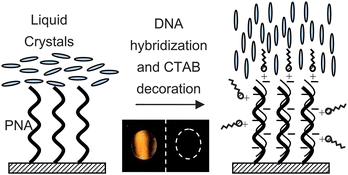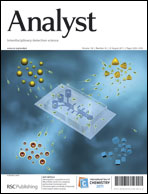In this paper, we report the formation of a DNA/cetyl trimethylammonium bromide (CTAB) complex on a solid surface and its interaction with a thin layer of liquid crystals (LC) supported on the surface. Our results show that when the surface is decorated with DNA only, the LC gives a bright image, but when the surface is decorated with the DNA/CTAB complex, the LC becomes dark when the surface density of CTAB is above 5.25 ± 0.13 × 1013/cm2. To exploit this phenomenon for detecting DNA targets, we used a surface decorated with electroneutral PNA probes for capturing DNA targets, and then treated the surface with 0.1 mM of CTAB. In the presence of DNA targets, a PNA/DNA/CTAB complex is formed and that leads to a dark image on the thin layer of the LC supported on the surface. Moreover, DNA targets with a complementary, 1-base mismatch and non-complementary sequence can be differentiated by using this method. This study provides a new principle for the label-free detection of DNA targets without any fluorescent labels.

You have access to this article
 Please wait while we load your content...
Something went wrong. Try again?
Please wait while we load your content...
Something went wrong. Try again?


 Please wait while we load your content...
Please wait while we load your content...